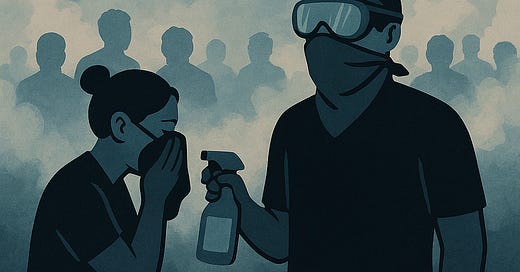How to Survive Tear Gas (Without Getting Arrested)
Field-tested protest survival strategies for dangerous times
I didn’t want to write this.
This was meant to be an informative piece—a tactical guide for “someday.” But as of now, it may be needed in real time.
If you're reading this in the U.S. today, you might be facing actual deployment of tear gas in civilian areas. Maybe it’s already happened in your city. Maybe you’re planning to show up. Either way, I’m not here to stir panic. I’m here to help you survive it.
This guide draws from protest responses in Chile, Hong Kong, France, Lebanon, Myanmar, and the U.S. It is rooted in nonviolence. These are defensive, field-tested actions—none of which rely on escalation or aggression.
Your first duty is to yourself and your family.
Your second is to your community.
Your third is to your country—if you’re still standing.
⚖️ Disclaimer
Legality varies by jurisdiction.
Before acting on any tactic below, consult local laws, legal observers, or civil rights organizations (e.g., the ACLU) for the most accurate legal guidance. Even peaceful actions can be interpreted differently depending on where you are.
BEFORE YOU ARRIVE
1. Protect your eyes and lungs
Wear sealed swim or lab goggles with no vents.
Use an N95 mask or dual-filter respirator.
Bring extras if possible. Lenses fog. Straps break.
2. Cover your skin
Long sleeves, hats, and gloves help limit contact.
Plastic wrap on wrists and neck can reduce cleanup time and irritation.
3. Bring flush supplies
Use saline spray (the safest option) to rinse eyes and skin.
Some protesters also use a 50/50 mix of liquid antacid and water (e.g., Maalox).
Pack multiple small spray bottles to share or toss to others.
WHEN TEAR GAS HITS
Scientific Note:
What we call “tear gas” is usually CS gas (2-chlorobenzalmalononitrile). It’s a solid compound, not a true gas—it’s aerosolized into fine particles. That’s why masks work, and why smothering canisters can reduce exposure.
4. Smother the canister
Cover the source with a traffic cone, then pour water or sand inside.
If no cone is available, use a pot lid, metal bowl, or bucket.
Never handle with bare hands—heat and chemical residue can burn skin.
5. Do NOT throw it back
In the U.S., throwing a canister back could lead to serious charges, such as assault or obstruction, depending on local laws.
Even if no one is harmed, the legal system often treats it as a violent act.
6. Move upwind and stay high
Wind spreads gas in its direction—move upwind and, if possible, uphill.
Avoid low-lying areas, alleys, or basements where CS particles settle and linger.
AFTER EXPOSURE
7. Flush—don’t rub
Blink rapidly and rinse eyes with saline, from the inner corner out.
Do not rub—this forces particles deeper and worsens irritation.
8. Remove contaminated clothing
Carefully strip and bag exposed clothes.
Wash skin with cold water and soap. Avoid hot water, lotions, or oils.
9. Help others
Look for mutual aid tents or designated medical volunteers.
Share water. Offer saline. Repeat instructions calmly.
Fear is more contagious than CS particles—don’t pass it on.
THE MOST IMPORTANT STRATEGY
Tear gas is a weapon of disorientation, not destruction. It’s designed to create panic and chaos, not wounds. Your calmness is more dangerous to authoritarian systems than your rage.
You don’t win by lashing out.
You win by holding the line and staying functional.
Teach others what you know.
Coordinate. Stay visible. Stay lawful.
You are not disposable.
🧠 Want the full playbook?
Find it at radicalleanings.substack.com, or search “Tear Gas” or “James Ergle” if you’re offline later.





